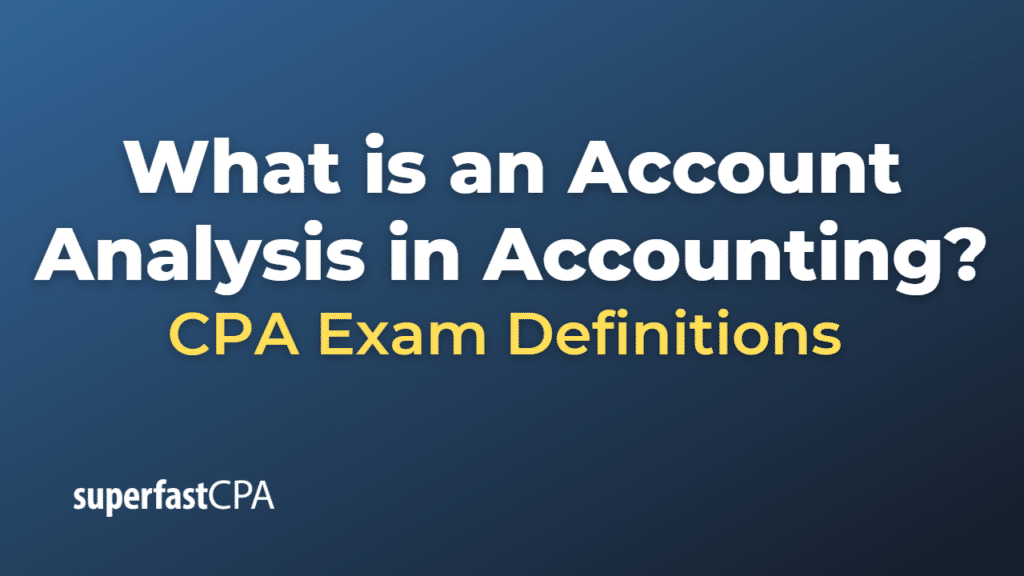Account Analysis in Accounting
Account analysis in accounting refers to the process of reviewing and examining the details of specific accounts within a company’s general ledger. The goal of account analysis is to identify any discrepancies, unusual transactions, or trends, ensuring the accuracy and completeness of the financial records. Account analysis is an essential component of financial management, internal control, and audit procedures.
Account analysis involves the following steps:
- Selection of accounts: Choose the accounts you want to analyze, which can be based on risk, materiality, or other criteria relevant to the business.
- Gathering data: Collect the transaction details, account balances, and supporting documents for the selected accounts. This may include invoices, receipts, bank statements, or other relevant records.
- Reviewing transactions: Carefully examine each transaction recorded in the account to ensure it is accurate, properly classified, and complies with the company’s accounting policies and applicable accounting standards.
- Investigating discrepancies: Identify and investigate any discrepancies, unusual items, or trends that may indicate errors, fraud, or inefficiencies. This may involve cross-referencing with other accounts, obtaining additional documentation, or discussing the issue with relevant personnel.
- Reconciling balances: Compare the account balance with external records, such as bank statements or supplier statements, to ensure the account is complete and accurate.
- Adjusting entries: If errors or discrepancies are identified, prepare and record adjusting journal entries to correct the account balances.
- Reporting and monitoring: Summarize the findings of the account analysis, communicate them to relevant stakeholders, and implement any necessary actions or controls to prevent future issues.
Account analysis is essential for maintaining the accuracy and reliability of a company’s financial records. It helps identify errors or irregularities in a timely manner and supports the preparation of accurate financial statements. Regular account analysis also contributes to effective internal control and risk management processes, as well as compliance with external audit requirements.
Example of an Account Analysis
Let’s consider an example of account analysis involving a company’s “Office Supplies Expense” account:
Background: XYZ Corp. has noticed a significant increase in its Office Supplies Expense over the last quarter. The management wants to understand the reasons behind this increase and ensure the account’s accuracy.
Here are the steps XYZ Corp. might take to perform an account analysis for the Office Supplies Expense account:
- Selection of account: Management selects the “Office Supplies Expense” account for analysis due to the unexpected increase in expenses.
- Gathering data: The accounting department gathers transaction details, account balances, and supporting documents, such as invoices, receipts, and purchase orders, for the last quarter.
- Reviewing transactions: The accounting department carefully reviews each transaction recorded in the account to ensure proper classification, accuracy, and compliance with the company’s accounting policies.
- Investigating discrepancies: During the review, the accounting department discovers a $3,000 expense entry that appears to be unusually large. Upon further investigation, they find that the purchase was for computer equipment, which should have been recorded as a fixed asset, not an office supplies expense.
- Reconciling balances: The accounting department reconciles the account balance with external records, such as vendor statements, and confirms no other discrepancies.
- Adjusting entries: The accounting department prepares and records an adjusting journal entry to reclassify the $3,000 computer equipment purchase from the Office Supplies Expense account to the appropriate fixed asset account.
- Reporting and monitoring: The accounting department summarizes the findings of the account analysis, reports the issue and corrective action to management, and implements additional controls to ensure proper classification of expenses in the future.
Through this account analysis, XYZ Corp. identified and corrected a misclassification error, resulting in more accurate financial statements. The process also helped the company improve its internal controls and reduce the risk of similar errors in the future.













